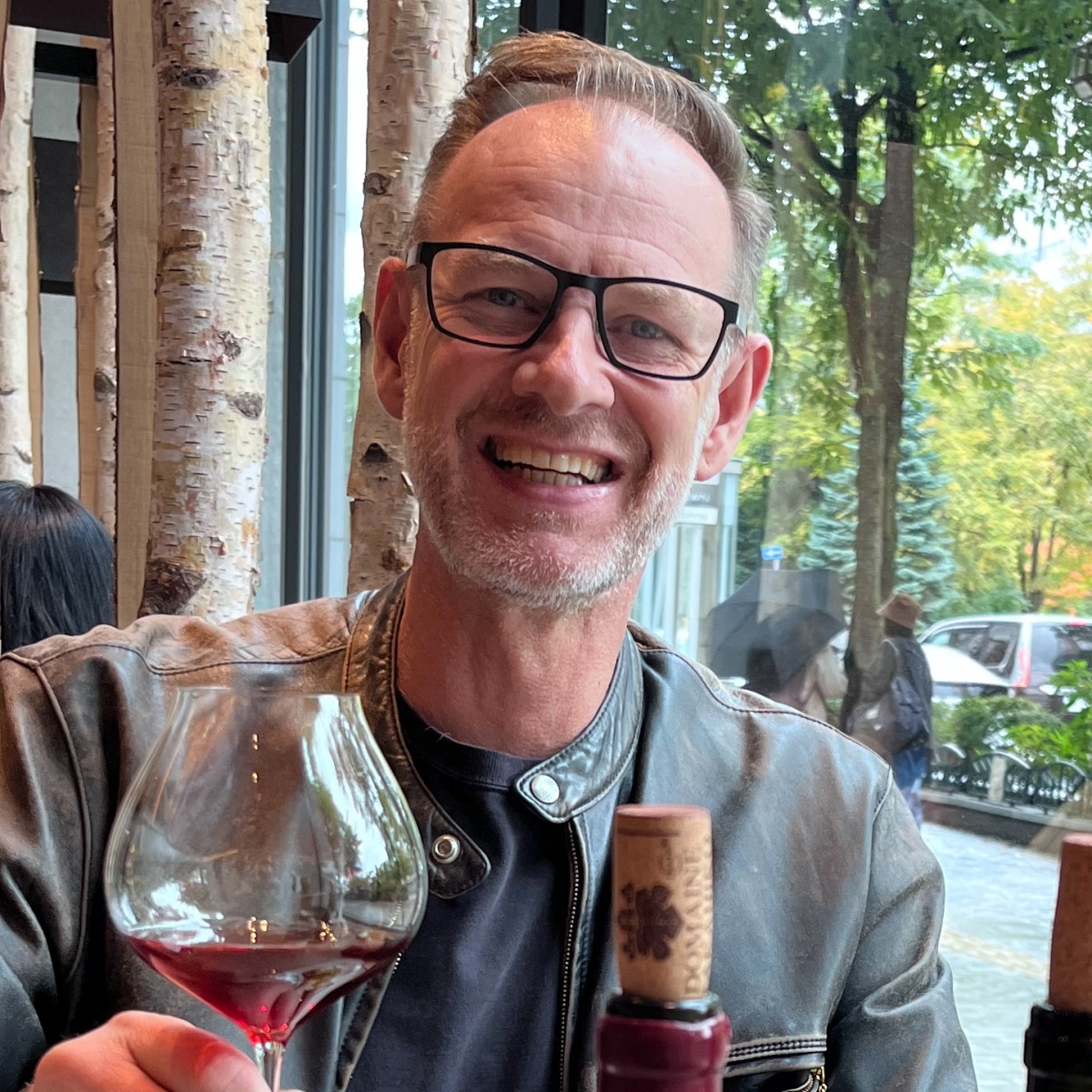Awaji Island Blue: Cycling Japan's Island Birthplace
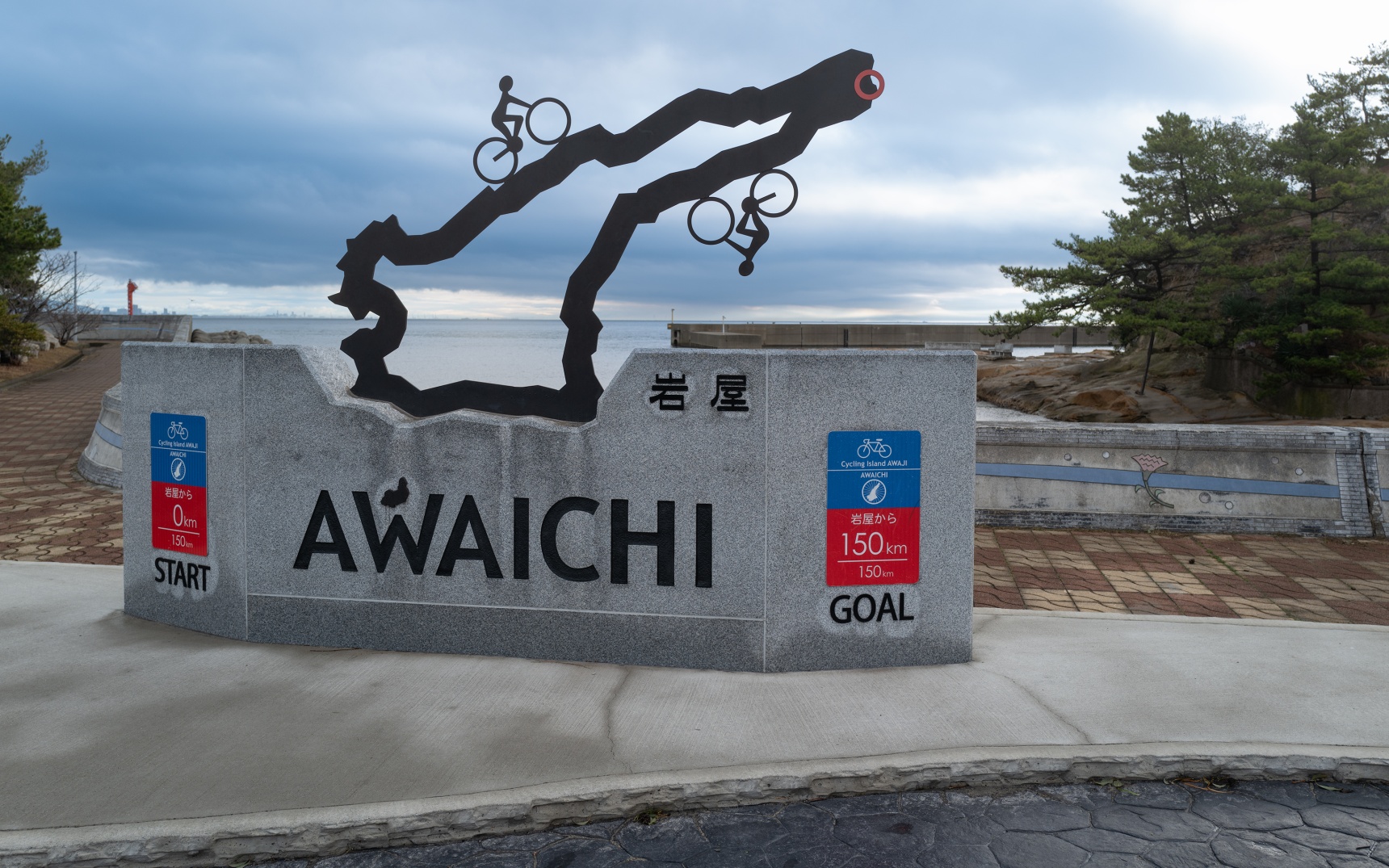
Awaichi is the name given to the 150-km cycling route around Awaji Island.
Located in the Seto Inland Sea between central Honshu and Shikoku Island, Awaji Island is the legendary birthplace of Japan. While cycling the island, Andrew Lee uncovered a thread that links its mythical, traditional, and pop-cultural aspects.
By Andrew LeeBy the promenade in Awaji Island’s port of Iwaya stands a metal sculpture shaped like the island, with two stylised cyclists riding around its edge. The word “Awaichi”—the name given to the 150-kilometer route that circuits the island—appears on the plinth, which is a common starting point for cyclists arriving from the mainland by boat.
I’d taken the 7:20 am ferry from Kobe to Awaji, which sits like a stepping stone between the islands of Honshu and Shikoku. According to legend, it is the birthplace of Japan, as it was here that divine siblings Izanagi and Izanami stirred the primordial ocean with a heavenly spear, creating the first landmass of the Japanese archipelago.
The best direction to ride around the island is clockwise, so you’re in the lane closest to the water. The local tourist association recommends several cycling routes, but I’d mapped my own three-day itinerary around specific places I wanted to visit. After adjusting the electric mountain bike I’d rented from Cyclism, a local bike store, I set off along National Route 28, which traverses the east coast. My destination was Sumoto, 40 km south of Iwaya, where I’d arranged to visit an aizome (indigo dyeing) workshop that afternoon and spend my first night.

The road to Sumoto hugged the shore beside Osaka Bay.
As I got used to the bike and felt its electric-assist kick in on the first hill, I realised I’d get to Sumoto earlier than expected if I stayed at my current pace. I slowed down, turned off Route 28, and started to relax, keeping the water to my left as I meandered south.
On the bike, I was free to weave through the narrow alleys of old neighborhoods, where the tiny kominka were so closely packed my shoulders brushed their walls. I could also ride along the concrete seawall, past rusting boat sheds and crumbling akiya, and catch my reflection in the huge windows of modern holiday homes.
Occasionally, I’d be politely greeted by a fisherman heading home, or someone out for a morning stroll. But it was still early, and the backstreets were mostly empty, save for cats—there are always cats.
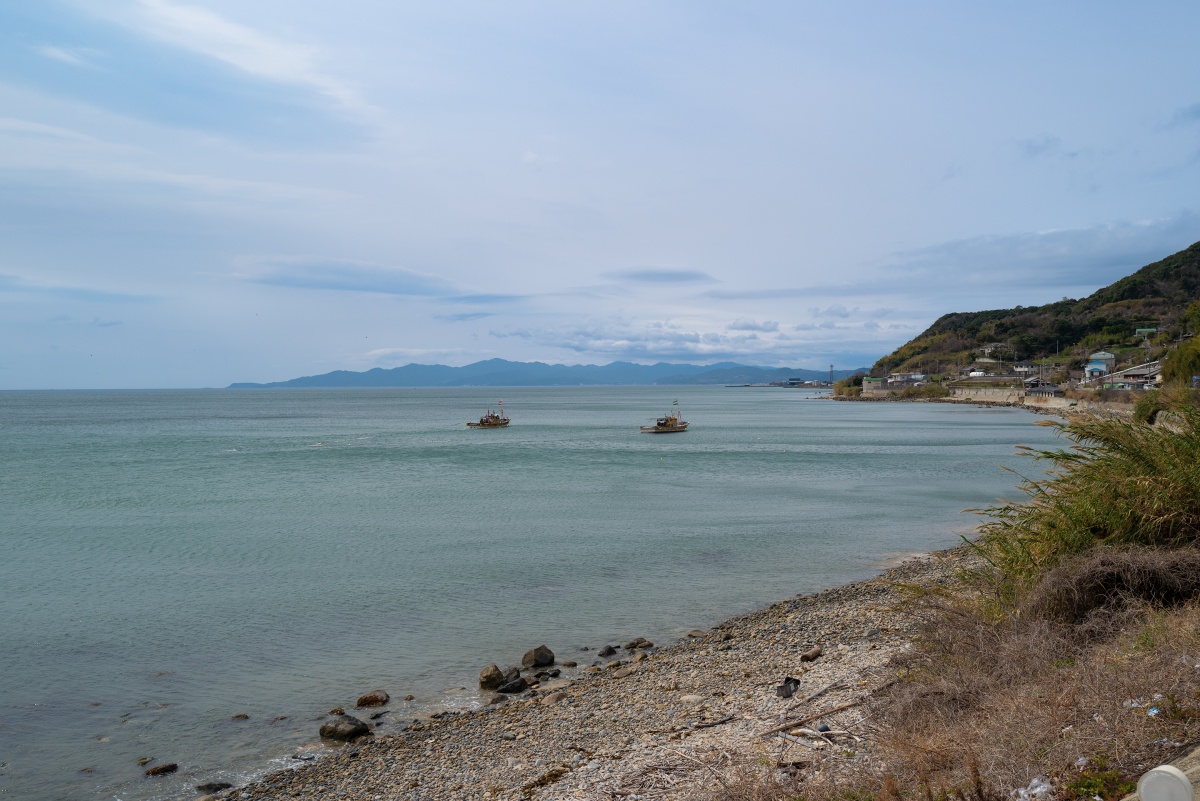
For several kilometres I rode parallel to a pair of fishing boats slowly heading south.
The island is famous for the early-harvested onions called shintamanegi, and I passed neat rows of their green stalks sprouting from unexpected places, vacant lots beside gas stations and between factory silos. Outside a road stop, a group of farmers were setting up to sell theirs to tourists. Inside, the cafe served curry rice (with onions), and the gift shop sold onion-flavored everything: soup, jam, pie, senbei crackers.
Between towns, Route 28 hugged the shore, with forested hills to the right and rocky cliffs and sandy beaches to the left. In the morning sun, the water was a brilliant turquoise, and for several kilometres I rode parallel to a pair of fishing boats dragging a net between them just offshore—its gentle wake breaking softly on the rocks.
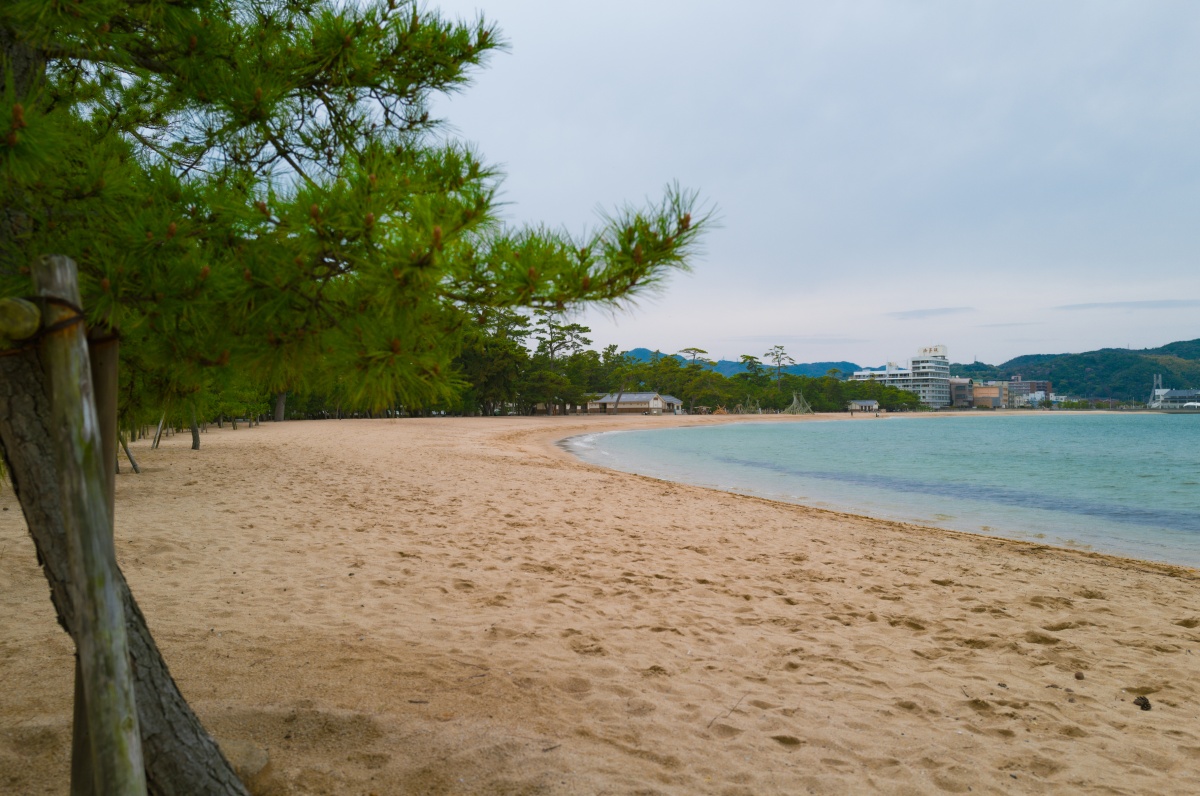
Sumoto’s Ohama Beach is one of the nicest I’ve seen in Japan.
It was early afternoon when I rolled into Sumoto and parked my bike at the Civic Plaza. I wandered the red-brick buildings of the town’s former cotton mill, now converted into a public library, restaurants, and an indoor play area for kids. In the plaza, there’s also a bronze statue marking the 30th anniversary of "Dragon Quest," the hit game created by Yuji Horii, a native son of Awaji.
On my way to the indigo-dye studio, I pedaled through the pine trees lining Sumoto’s Ohama Beach—one of the nicest I’ve seen in Japan. Its golden sand surprised me; I’d grown used to the darker volcanic sand of beaches closer to Tokyo, and made a mental note to return in summer.
Near the beach are several old resort hotels and a large sign proclaiming “Sumoto Onsen.” But the only public hot spring I found was a foot bath, where I soaked my feet beside a cute statue of a tanuki raccoon dog—one of eight scattered around town celebrating the shape-shifting creatures that bring luck, mischief, and protection to the area.
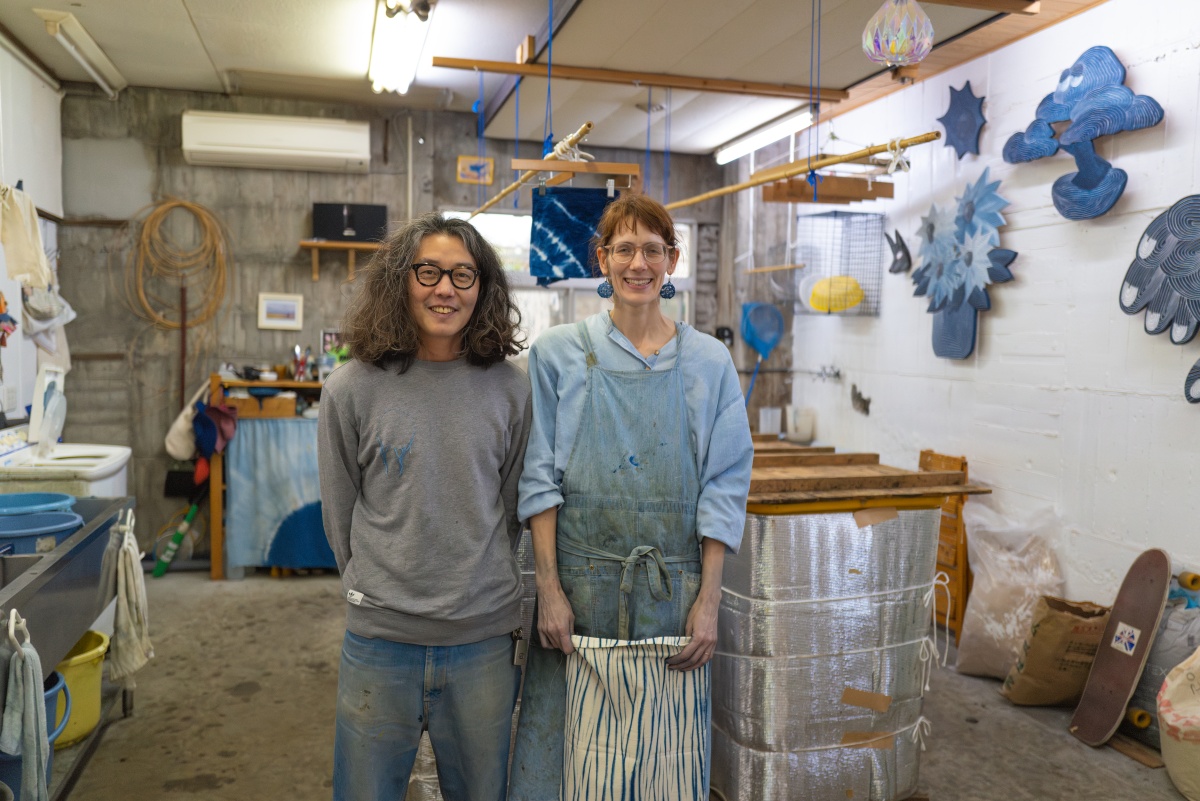
Sally Hancox and her husband Junichi opened their indigo dye studio, Ai Aii, in Sumoto in 2020.
At Ai Aii Natural Indigo Dye Studio, I was greeted by co-owner Sally Hancox. We shook hands, and I noticed hers were stained blue. Inside, her husband Junichi stood beside several large dye vats, wrists deep in the black liquid, dyeing a T-shirt for a client.
I'd brought a couple of small white hand towels, and Sally showed me how to tie one with rubber bands for a tie-dye effect, and clamp wooden blocks on the other to make white stars on a blue background.
“Do you want to wear gloves?” she asked as we started.
“No. I’m fine with blue hands,” I said. “Proof I’ve been here!”
I dunked the first towel into the vat, my hands disappearing into the deep, indigo dye. Sally guided me through the process, and we chatted about how she ended up on Awaji.
Originally from London, she met Junichi in Osaka, and the two moved to Awaji in 2015 with no real plan other than to raise a family surrounded by nature, and to do something “creative and fun.” It was a dream I could totally relate to.
In 2020, they opened Ai Aii, the shop and studio where they now run workshops. They also grow their own organic indigo plants to make sukumo, the dried and fermented leaves used to produce the dye.
“I never imagined I’d end up farming indigo in the Japanese countryside,” Sally said with a laugh.
We untied the towels, revealing the lovely blue-and-white patterns we’d created. Before I left, I washed my hands with soap, watching the foam turn sky blue. Sally warned me the stain would linger for days.
“At least I’ll have something to talk about,” I said.

My stained hands became a talking point after attending a workshop at Ai Aii Indigo Dye Studio.
That evening, I left the bike at my hotel and walked through the Retro Sumoto Komichi area, where some cool Showa-era buildings have been converted into shops and restaurants. I also came across a covered shopping arcade with the name “Commode 56,” and eventually ended up at Awayan, a kushikatsu (deep-fried skewers) place Sally had recommended.
With a blue hand, I pushed aside its red noren and stepped in.
It was a small place, with eight seats tucked around its L-shaped counter. I took a seat by the wall and looked at the daily specials. I ordered a beer and a few sticks of food including beni-shoga (ginger pickled in plum vinegar), a Kansai specialty.
As he passed me my beer, the owner noticed my hand. “Aizome?”
“Yeah, I guess that’s hard to hide!” I said. The customer next to me was curious, so I proudly showed off the towels I’d dyed.
After dinner, I walked a couple of blocks to Awajishima Blues, a cozy record bar painted white inside and out, and decorated with music memorabilia and cigarette smoke. “Hey Jude” was playing as I walked in, and I had to smile.
Every night for months, I’ve played “Hey Jude” to calm my baby son before bed— and here it was, right on time, in a bar called Blues, and I had blue hands. Occasionally, there are moments when you’re exactly where you’re meant to be.
“Aizome?” asked the man drinking his highball next to me.
Gen, the bar’s friendly owner, told me he opened the place when he was just 21. He’s 35 now, and it’s clearly a local institution, with regulars of all kinds popping in for a drink. The Osaka Expo was a popular topic of conversation that night.
On a shelf sat figurines of the two Expos’ mascots—the multi-eyed, cronut-shaped Myaku-Myaku of the current expo, and Taro Okamoto’s iconic Tower of Sun from 1970. Beside them was what I took to be a figure of Sid Vicious, but Gen informed me it was Kiyoshiro Imawano—Japan’s own King of Rock—and reached into his vinyl collection to play him next.
I drank a couple of beers and learned that Gen was an Oasis fan, while a businessman requested The Carpenters, and someone else asked for Queen. As I left, a blues classic by Dr. Feelgood was playing, the last notes of blue in an indigo day
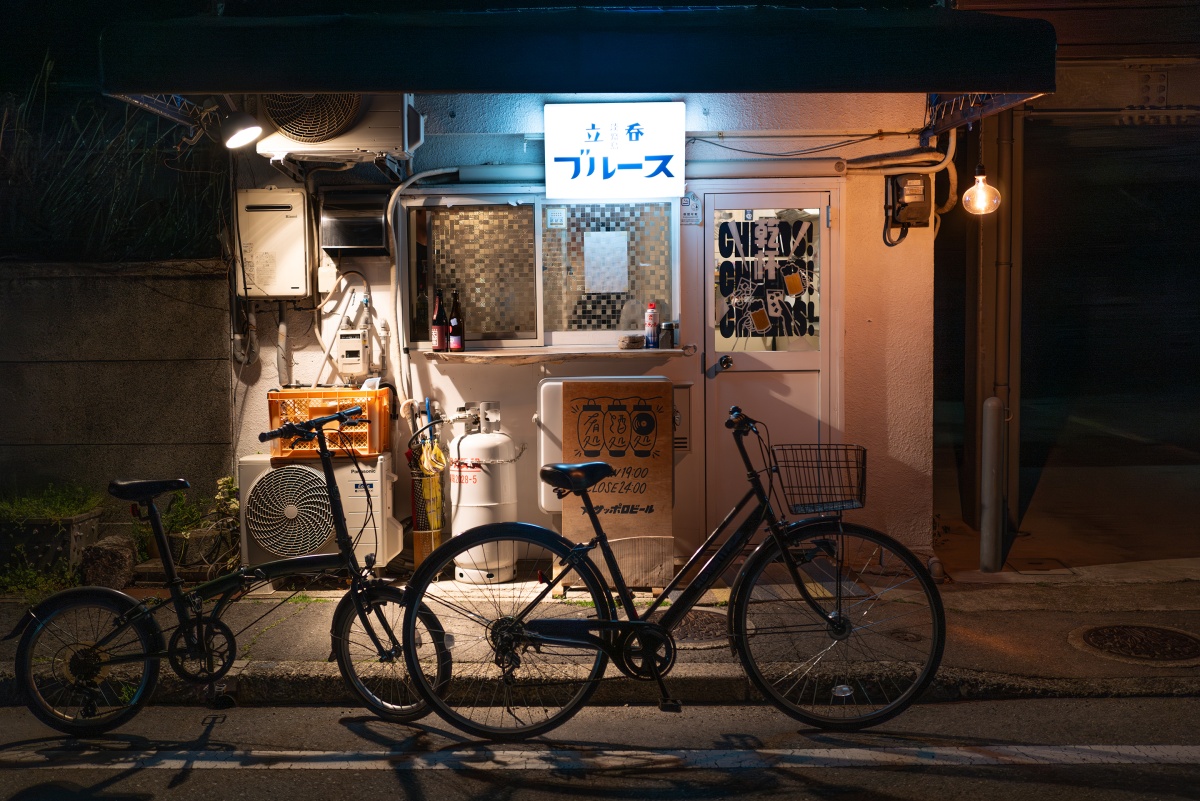
Awaji Shima Blues is a cozy record bar in Sumoto.
The next morning, I had breakfast at a stylish cafe called Classic+Place. I ordered a strong latte and the barista looked at my hands, now a slightly lighter shade of blue after my morning shower.
“Aizome?” She mentioned she knew the folks from Ai Aii, and I was starting to see how closely knit the community is on Awaji.
After coffee, I started riding west. I was soon deep in farm country, zigzagging through rice paddies and more onion fields. I passed a field of brilliant yellow flowers glowing in the morning sun. A sign read “Awaji Rape Flower Eco Project,” and a woman stopped me to explain that the flowers are grown in abandoned lots to make rapeseed oil, which is then recycled into biofuel. Each year, they create a playful maze among the blossoms—and I was soon hopelessly lost.
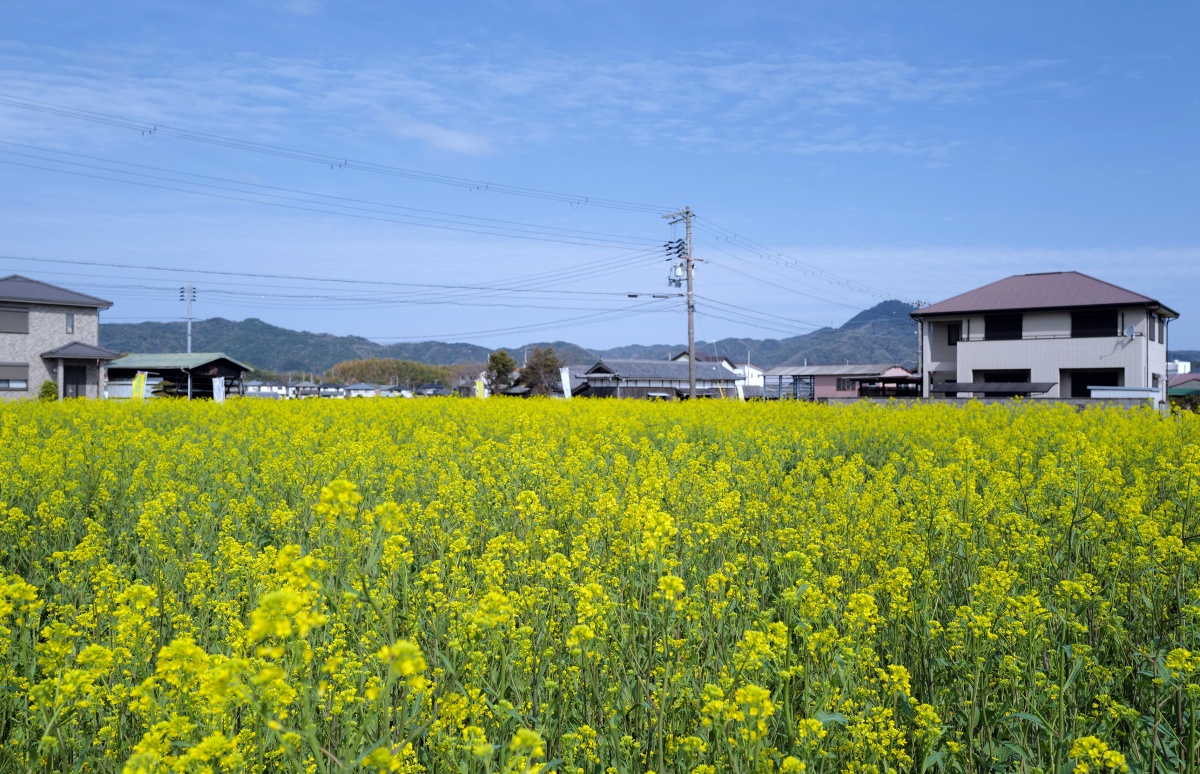
The “Awaji Rape Flower Eco Project” makes rape seed oil that is then recycled after use into bio fuel.
Setting off again, I began to climb into the hills. I’d booked lunch at Yumegura, a farm-to-table restaurant in a restored 80-year-old farmhouse hidden in a valley. To get there, I would have to cross a mountain or two.
My route took me up a road that narrowed until it was a mere track beside a stream. Carefully, I rode across a crumbling concrete bridge, into acres of solar panels on the hillside, before rejoining a proper road that passed sheds of dairy cows being milked.
Even with the e-bike’s power, I was pedaling hard as the roads grew steeper, and every now and then I’d pause to catch my breath and admire the view. In the forest, I heard the sweet whistling of an uguisu, the Japanese bush warbler, while a gentle breeze knocked the bamboo together.
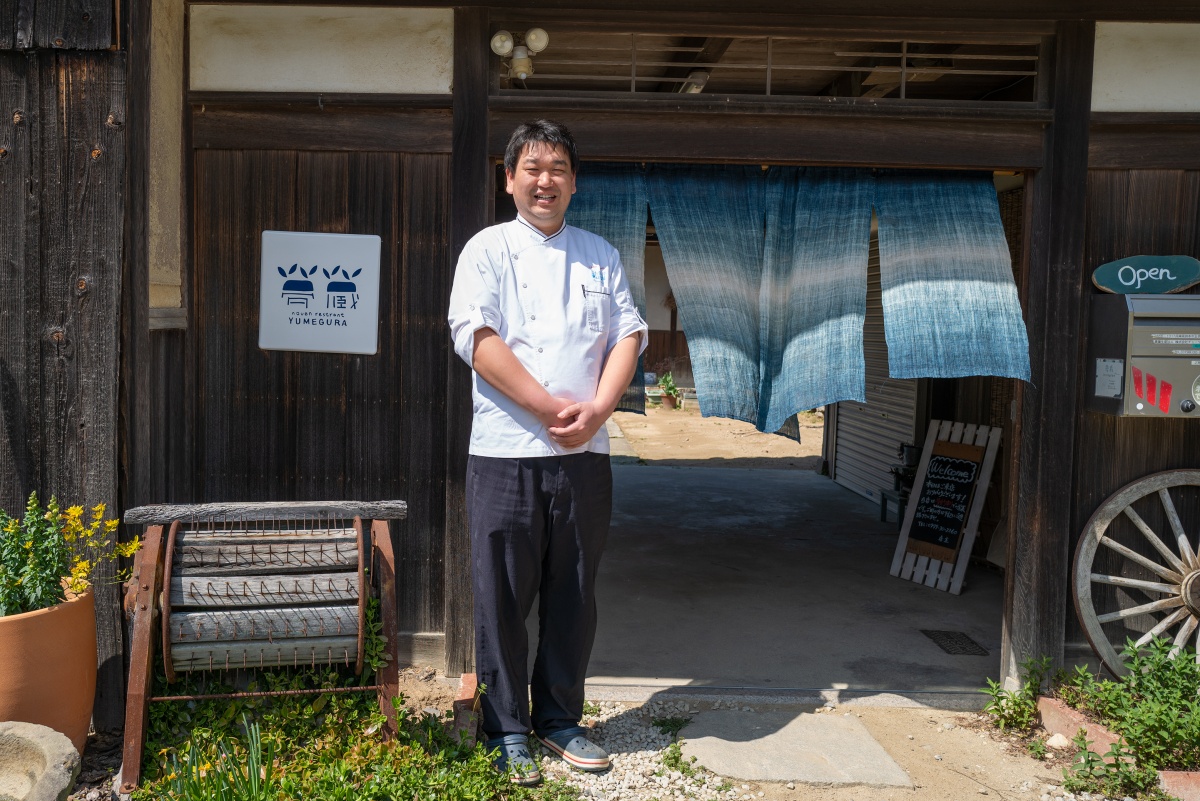
Chef Takeshi Horii serves what he describes as Wa French cuisine in a beautiful 80-year-old farmhouse in a hidden valley on Awaji Island.
At Yumegura, a beautiful indigo noren hung at the entrance. Inside was a courtyard garden and the gorgeous main house. The restaurant is run by chef Takeshi Horii and his wife, Natsu. As she seated me at a low table in a charming tatami room, Natsu glanced at my hands.
“Aizome?” she asked. I wasn’t surprised when she said their noren was made by Sally and Junichi.
Lunch was superb. Horii serves what he calls “Wa French” cuisine—a French style designed to be eaten with chopsticks. He uses seasonal ingredients from Awaji farms, and that day’s menu included roast Awaji beef, kiku imo (Jerusalem artichoke) with cheese and onion sauce, sakura trout and sweet potato salad, and, of course, a shin-tamanegi soup. I also had a refreshing soda made with Awaji’s local Naruto oranges—bittersweet like marmalade and absolutely delicious.
When I asked Natsu if she knew of my next stop, a ceramics atelier called Awabi Ware, she pointed to my bread plate and said, “This is Awabi Ware.”
Two hours later, I parked my bike in front of the charming whitewashed, green-tiled building of the former clinic that houses the Awabi Ware studio and shop.
Ceramic artist Junichi Okamoto started the brand in 2012 with the idea that tableware should be passed down like family heirlooms. After graduating in sculpture from Musashino Art University in Tokyo, he taught there for several years before returning to his hometown on Awaji in 2010. He began making pottery inspired by Awaji-yaki (also known as Minpei-yaki), a style of tableware produced on the island from the mid-1800s until the start of World War II.
In a glass cabinet by the shop entrance were colorful antique pieces glazed in the traditional greens, yellows, and blues of Awaji-yaki. But Okamoto softened the palette to suit modern tastes, and his range includes pastels alongside the brighter colors, in matte or glossy finishes. One serving plate caught my eye—glazed in an iridescent turquoise, the shade of the sea I’d ridden beside the day before.
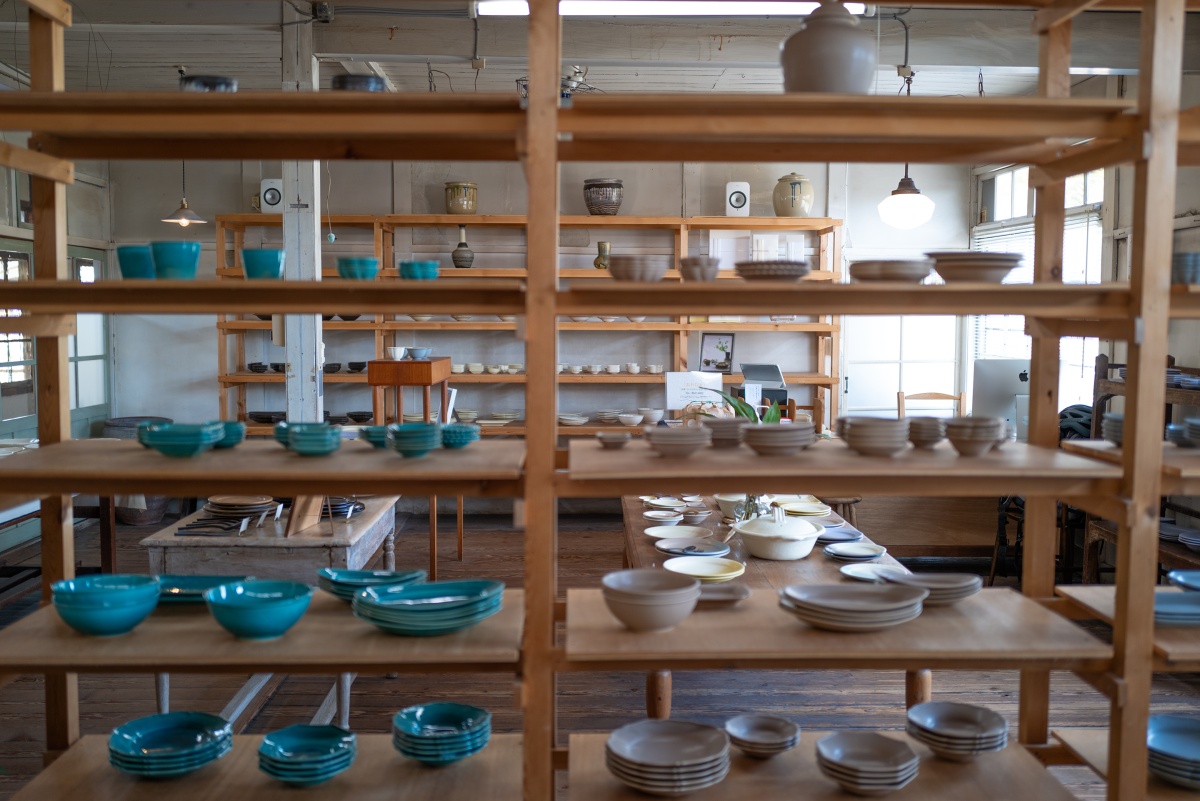
The ceramics at Awabi Ware are influenced by the traditional Awaji-yaki pottery made on the island in the late 1800s.
I left wishing I had more room in my pack, and continued riding west toward Izanagi-jingu—Japan’s oldest Shinto shrine, said to have been founded by the god Izanagi himself. The main shrine was under repair and wrapped in scaffolding, which was a little disappointing. But nearby, couples were lining up to make offerings at Meoto-no-okusu, a pair of 900-year-old camphor trees that have fused into one—a symbol of a long and harmonious marriage.
I reached the west coast at the nearby port town of Gunge and began riding north.
It felt very different to the east. On the way to the guest house where I stayed my second night, I rode through a strip of touristy BBQ and pizza joints promising photogenic sunset views. They felt temporary—the kind of places that might not last five years—and it was heartbreaking to see a traditional kominka farmhouse among them being torn apart by the claws of an earth-mover.
But the harsh reality is that much of this area still hasn’t recovered from the Great Hanshin Earthquake, which struck thirty years ago. The Nojima Fault—which triggered the quake on January 17, 1995—cuts across the top of the island and runs down its west coast here. In some places, the land was displaced 1.5 meters, causing catastrophic damage. Even now, there are vacant lots and abandoned homes. So while these cheap tourist traps may not be built to last, for now they’re bringing visitors to a region that badly needs them.
Since the 2010s, Hyogo Prefecture and Awaji City have supported such private-led developments to help revitalize the region. The most prominent player is the Pasona Group, responsible for a mishmash of pop-culture related attractions including the sprawling Nijigen no Mori theme park—with sections based on Naruto and other anime, plus a zip-line that flies into the mouth of Godzilla—as well as restaurants, wellness resorts and two Hello Kitty attractions along the coast.
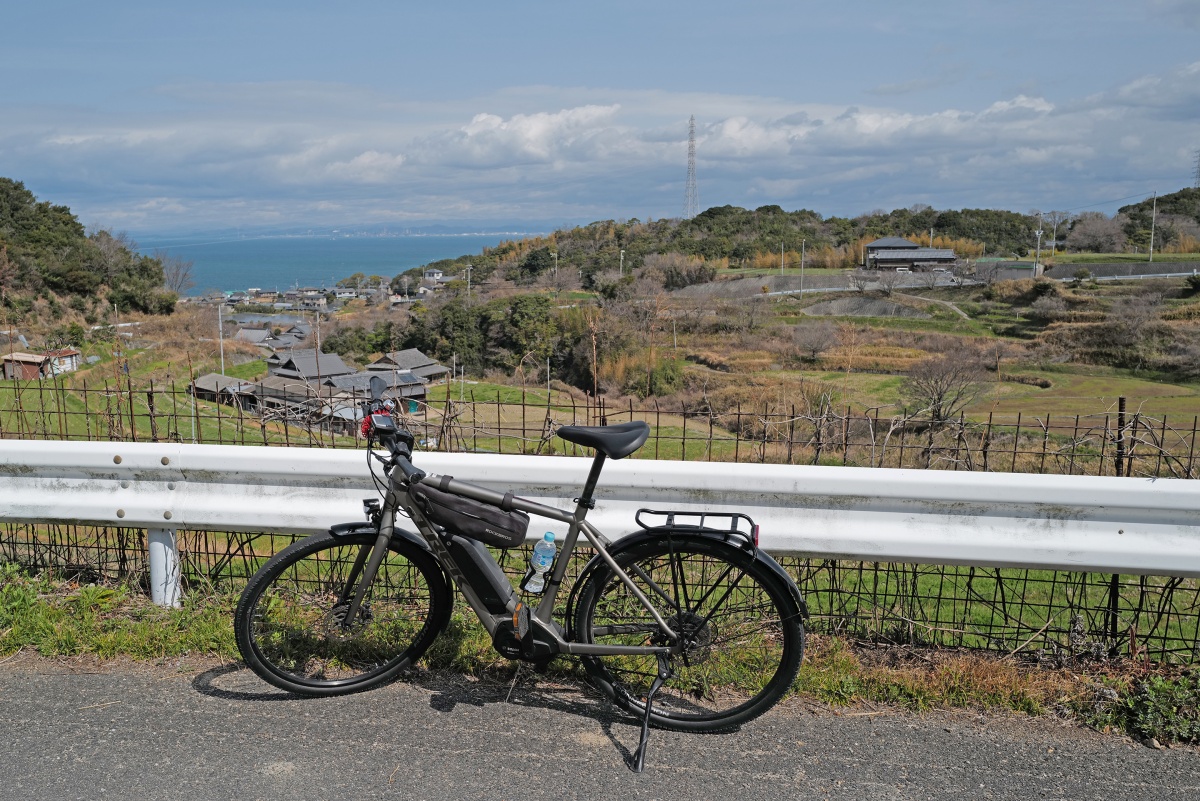
Cycling around Awaji is a great way to get off the tourist path and explore the island.
I began the final day of my trip with breakfast at Sakia, a community hub in a former elementary school that includes a hotel, co-working space, and bakery restaurant. It’s part of a regional regeneration project backed by a restaurant group that, like Pasona, is doing what it can to revitalise the area.
From there, my route took me back over the mountains to the east coast. I rode beneath the towering freeway that cuts through the island, the sound of traffic faint above me as I followed empty roads overgrown with weeds. I stopped for lunch at Awaji Winery — the island’s only wine producer—and was shown a vineyard they’re planting on disused farmland.
With legs like jelly, I ended my climb at Awaji Hanasajiki, a popular sightseeing spot where fields of purple murasaki hana (Chinese violet cress) and yellow rape flowers bloomed before a spectacular view of the east coast.

My route took me down steep back roads beneath the towering freeway that cuts across the island.
From there it was downhill all the way, and I was glad to be on a mountain bike. I whizzed down dirt tracks through forests and fields, past rusting abandoned cars, curious grazing cows, and a farmer who called out, “Where from?”
When I pulled up in front of the Aqua Ignis Awaji complex, where Cyclism is located, the odometer on my bike read 98.03 km. As tempted as I was to round it off to an even 100, the onsen next door was calling.
Soaking my aching muscles in the hot spring water, I looked down at my pale blue hands. If Awaji Island really is the birthplace of Japan, then perhaps the contrast I’d seen—between its mythical, traditional, and pop-cultural aspects—perfectly encapsulates the country and its history. I’d deliberately avoided certain places, but realise they are likely helping to revitalise the island. Personally, I was glad to have met people who are taking a more grassroots approach—and I felt lucky to have stumbled onto a thread that quietly, and quite beautifully, tied them together.


